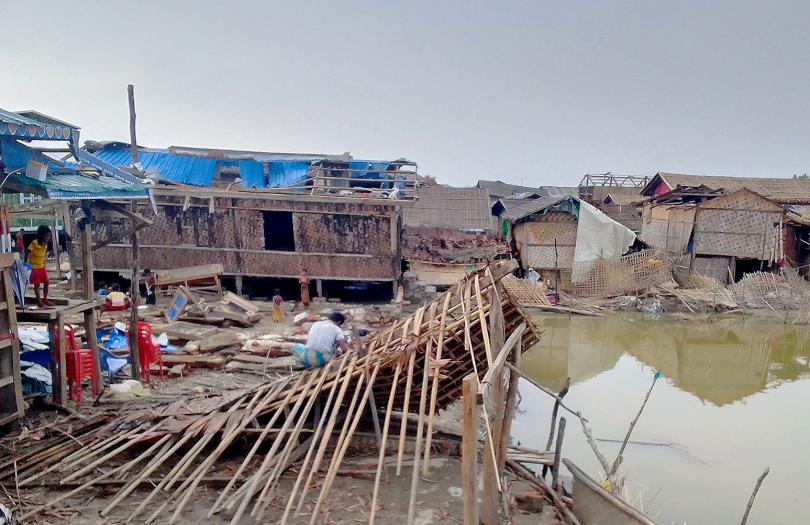A nightmare in monsoon: the lives affected by the cyclone

A man standing on the land where 80%of the area had been destroyed by the disaster was looking at the scenes before him; the damaged houses, including his, and the deteriorated neighbourhood that he could no longer remember how he lived here.
"A strong wind made starting to crack our roofs. Rain is leaking in from above. I heard the shouting voices from far away through the roaring wind. We all were soaking wet.", Maung Thein explained while recalling the memories he went through.
Maung Thein is a camp-based staff from Save the Children. Also, he is a resident of the displaced camp near the coastal area of Rakhine State that was recently hit and destroyed by Cyclone MOCHA in the second week of May.
"Cyclone came to us on May 14.I still clearly remember every moment of then,” he said.
Before the Cyclone approached the coastal area of Myanmar, he saw similar posts on Facebook mentioning, 'A Cyclone MOCHA, which is more intense than Cyclone NARGIS, is moving towards Myanmar' and he had no idea where it was going to be a direct hit. Then he forgot about those warnings, as internet connectivity was terrible at the camp where over 10,000 displaced people lived.
"On May 11, I got a call from my supervisor that our place was predicted on the way of Cyclone path and going to be hit with strong intensity. My brain was not working properly at that time, with the worry about my family and the people in my camp as they had no idea about cyclone warnings and the damage it might cause."
The supervisor also informed Maung Thein that they had to attend Cyclone Awareness and Preparation Training on May 12 and 13 to prepare and spread cyclone information. Simultaneously, Maung Thein told the camp committee about the possibility of the Cyclone and the preventive measures they must take immediately.
"Together with their coordination, we went around both camps warning about the danger of the Cyclone and urging them to relocate to the high ground or safe place immediately in one day. Almost everyone in both camps left their home except a few men who remained to guard the properties. My family also relocated to another camp located in a hilly region, which took three hours by boat," he continued with a voice that felt like it was back then.
The Cyclone MOCHA started to hit around 10 am and stopped at 4 pm on May 14. Although the displaced people relocated to a high-ground area, the buildings in that camp were not strong enough to endure extremely intense wind.
The wind was shaking them. The house's columns, they seek protection, were broken down by the winds. Calming after a while, the Cyclone became powerful again around 8 pm and became weak around 10 pm on May 14. He would never forget to bear a storm in a pinch black night with the fear of death.
"Luckily there was some boat running after the storm. So, I came back to my home the next morning.More than 75% of the houses were destroyed, including mine. I thought it was flooded high yesterday. 80% of the camp area has been affected by seawater intrusion. I can't imagine if we didn't get the Cyclone alert earlier and couldn't move in time. We could have died by now," Maung Thein explained.

40% of the road access inside the camp has been damaged, but the villagers are making every possible effort to clean and restore the roads. Until now, transportation by boat has been the only option to reach the camp.
"With the tarpaulin sheets he kept before the storm, he built a temporary shelter where his whole family is staying now. I have one bag of rice left. No idea after it is all gone. Now, we share food as some households have nothing but only clothes they have on their bodies. The price of basic commodities became very high at 1,000 kyats (0.5 USD) per egg which used to cost 200 kyats (0.1 USD). However, even if we have enough money, wecan'tpurchase as much as we want, including medicines. No markets or shops are running at this moment."
Currently, Maung Thein is worried about the diarrhoea outbreak as some children are already suffering from this disease. Water facilities were damaged by 85%, and the displaced people rely on collected rainwater. All three ponds in the camp have been inundated with seawater, except for one pond located on higher ground, which can provide water for approximately two weeks.
"As a Save the Children staff, I will be working, as best as I can, to help and support the people who suffered from the Cyclone. They are now in urgent need of food, shelter, clothing, and hygiene facilities," he concluded.
All those who have faced the disaster will not be able to forget what happened to them for a long time, experiencing their second homes in the displaced camps destroyed by the storm and losing their properties in the blink of an eye. Only the helping hands that warmly touch their hearts would encourage them to survive again and resume their daily lives.




